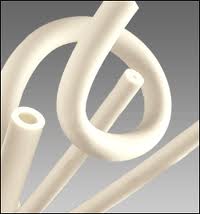Thermoplastic elastomers (TPE), sometimes referred to as thermoplastic rubber Sole, are a class of copolymers or a physical mix of polymers (usually a plastic and a rubber) which consist of materials with both thermoplastic and elastomeric properties. While most elastomers are thermosets, thermoplastics are in contrast relatively easy to use in manufacturing, for example, byinjection molding. Thermoplastic elastomers show advantages typical of both rubbery materials and plastic materials. The principal difference between thermoset elastomers and thermoplastic elastomers is the type of crosslinking bond in their structures. In fact, crosslinking is a critical structural factor which contributes to impart high elastic properties.
There are six generic classes of commercial TPEs:
- Styrenic block copolymers (TPE-s)
- Polyolefin blends (TPE-o)
- Elastomeric alloys (TPE-v or TPV)
- Thermoplastic polyurethanes (TPU)
- Thermoplastic copolyester
- Thermoplastic polyamides.
Examples of TPE products that come from block copolymers group are Arnitel (DSM), Solprene (Dynasol), Engage (Dow Chemical), Hytrel (Du Pont), Dryflex and Mediprene (ELASTO), Kraton (Kraton Polymers), Pibiflex (SO.F.TER.).
In order to qualify as a thermoplastic elastomer, a material must have these three essential characteristics:
- The ability to be stretched to moderate elongations and, upon the removal of stress, return to something close to its original shape.
- Processable as a melt at elevated temperature.
- Absence of significant creep.
















